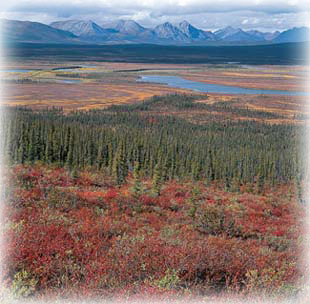About the Exhibit
The exhibit contains forty-nine photographs by Subhankar Banerjee, documenting the ecological diversity and Native cultures of Alaska's Arctic National Wildlife Refuge in all four seasons of the year.
The 19.5-million-acre Arctic National Wildlife Refuge contains the complete arctic and sub-arctic ecological zones from coastal tundra to mountains to taiga and boreal forest, making it one of the last untouched arctic ecosystems in the world.
For two years beginning in March 2001, Banerjee traveled some 4,000 miles on foot, raft, kayak, snowmobile, and bush planes, visually recording this extraordinary area. He survived blizzards with negative-40 degree temperatures to photograph and document the yearly cycles of the arctic animals, plants, birds, water, and indigenous peoples-the Inupiat Eskimos and Gwich'in Athabascans of this remote land.

|
Banerjee's photographs do not romanticize the landscape. In his own words the artist states, "Employing simple compositions, mostly subdued light of cloudy days, and a meditative process of observation, I wanted to portray the duality of grandness and simplicity. My study is a representation of fragility and vulnerability of grand landscapes." The New York Times senior art critic Roberta Smith called these images "stunningly beautiful." Ingrid Sischy, editor-in-chief of Interview and former photography critic of the New Yorker wrote, "Banerjee's landscapes seem epic." New York-based art critic Hilarie M. Sheets wrote in ARTnews that Banerjee's photographs are "evocative of paintings by Antoni Tapies," a major expressionist painter of the twentieth century. Banerjee's interpretation of this wilderness focuses on the mutually dependent relationships between the area's land, animals, water, and Native people.
The Refuge is one of the largest preservation areas in the world, containing the greatest diversity of plant and animal life in the circumpolar north. It contains 36 species of land mammals, nine species of marine mammals, 36 species of fish among its 20 rivers and numerous lakes, and 180 species of birds that congregate in the short seasons of spring, summer, and fall from six continents.
Banerjee's arctic project was sponsored by the Blue Earth Alliance, a Seattle-based non-profit organization. The extensive educational outreach program has been sponsored by The Mountaineers Books in Seattle with a generous grant from the Lannan Foundation of Santa Fe. While the exhibit is on display, the Burke Museum will collaborate with numerous regional environmental groups to provide related programming and educational opportunities for the public. Among these groups are the local chapters of The Mountaineers, Blue Earth Alliance, The Wilderness Society, and Seattle Audubon Society.*
The exhibit is accompanied by the book, Arctic National Wildlife Refuge: Seasons of Life and Land. In the publication's foreword, former President Jimmy Carter comments: "It will be a grand triumph for America if we can preserve the Arctic Refuge in its pure, untrammeled state. To leave this extraordinary land alone would be the greatest gift we could pass on to future generations." The book, published by The Mountaineers in 2003, will be available for sale at the museum's shop.
Born in Berhampore, a town near Calcutta, India in 1967, Banerjee received his bachelor's degree in engineering in 1989 before moving to the United States. He holds masters degrees in physics and computer sciences from New Mexico State University in Las Cruces. He worked as a scientist for six years at Boeing before switching careers to become an artist. Today, he makes his home in Seattle, Washington and New York City.
The exhibit is particularly timely, arriving in the midst of the debate over opening about 1.5 million acres of the Arctic Refuge to oil drilling. During its debates about the 2006 budget, the U.S. House of Representatives stated that drilling in the arctic should not be included in the legislation. But on March 16, 2005, in a 51-49 vote, the U.S. Senate voted to include drilling in its version of the bill. Congress will have to settle these two positions as the budget process progresses.
|